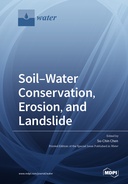Explore

Soil-Water Conservation, Erosion, and Landslide
0 Ungluers have
Faved this Work
Login to Fave
The predicted climate change is likely to cause extreme storm events and, subsequently, catastrophic disasters, including soil erosion, debris and landslide formation, loss of life, etc. In the decade from 1976, natural disasters affected less than a billion lives. These numbers have surged in the last decade alone. It is said that natural disasters have affected over 3 billion lives, killed on average 750,000 people, and cost more than 600 billion US dollars. Of these numbers, a greater proportion are due to sediment-related disasters, and these numbers are an indication of the amount of work still to be done in the field of soil erosion, conservation, and landslides. Scientists, engineers, and planners are all under immense pressure to develop and improve existing scientific tools to model erosion and landslides and, in the process, better conserve the soil. Therefore, the purpose of this Special Issue is to improve our knowledge on the processes and mechanics of soil erosion and landslides. In turn, these will be crucial in developing the right tools and models for soil and water conservation, disaster mitigation, and early warning systems.
This book is included in DOAB.
Why read this book? Have your say.
You must be logged in to comment.
Rights Information
Are you the author or publisher of this work? If so, you can claim it as yours by registering as an Unglue.it rights holder.Downloads
This work has been downloaded 101 times via unglue.it ebook links.
- 101 - pdf (CC BY) at Unglue.it.
Keywords
- alpine meadow
- alpine swamp meadow
- breach model
- bridge pier
- Climate Change
- dam breach
- debris flow
- deciduous broadleaved tree
- deep lip surface
- deep neural network
- degradation of riparian vegetation
- dendrogeomorphology
- earth system science
- Environmental science, engineering & technology
- extreme events
- extreme rainfall
- extreme rainfall-induced landslide susceptibility model
- Extreme Weather
- feature selection
- flume test
- Gaussian process
- grey correlation analysis
- gully erosion
- hillslopes
- hydrologic model
- ICU
- image classification
- Jiuzhaigou Valley
- laboratory model test
- Lancang–Mekong River basin
- land cover changes
- Land use
- landform change impact on pier
- landslide
- landslide activity
- landslide evolution
- landslide hotspots
- landslide probability model
- landslide ratio-based logistic regression
- loess
- Machine learning
- mechanical behavior
- mitigation countermeasures
- MUSCL-Hancock method
- n/a
- naïve Bayes
- outburst flood
- overfall
- overtopping
- pore structure
- PSED Model
- radial basis function kernel
- rainfall erosivity factor
- rainfall threshold
- rill erosion
- root distribution
- root system
- RUSLE
- safety factor
- scour
- sediment yield
- seepage
- seismic signal
- shallow landslides
- shallow water equations
- Shirakami Mountains
- simulated annealing
- soil erodibility
- Soil erosion
- Soil management
- spatiotemporal cluster analysis
- spectrum similarity analysis
- static liquefaction
- susceptibility
- syria
- Taiwan
- Technology, engineering, agriculture
- Technology: general issues
- tensile crack
- tensile strength
- tree ring
- TVD-scheme
- Typhoon Morakot
- USLE R
- vegetation community
- vegetation importance value
- vegetation restoration
- water erosion
- weighted subspace random forest
- wet-dry front
- Zechawa Gully
Links
DOI: 10.3390/books978-3-0365-3431-2Editions

